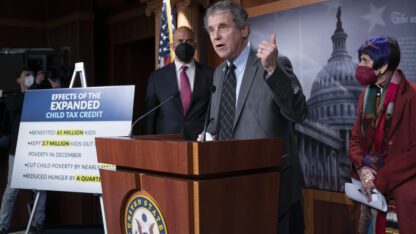It was heralded as a game-changer for America’s social safety net. It dramatically reduced child poverty. But, last month, the enhanced Child Tax Credit — a kind of “social security for kids” — expired, and millions of American children sank back into poverty.
In March 2021, President Biden and congressional Democrats revamped the Child Tax Credit as part of the American Rescue Plan. They restructured it, so that parents could get a monthly check from the government. They increased the credit’s size, allowing parents to claim as much as $3,600 a year per child, or $300 a month. And they made the credit fully refundable, so that even super low-income families who don’t pay much — or anything — in federal taxes could get it.
For those primarily concerned with ending child poverty, these changes were a resounding success. Scholars at Columbia University found they reduced child poverty by about 30 percent. Another study found the enhanced program cut household food insufficiency by 26 percent.
But President Biden’s efforts to renew the credit have been thwarted by opposition from Senator Joe Manchin (D-West Virginia) and congressional Republicans. They disliked how much the program cost, how generous it was, and they worried that it encouraged parents to stop working because it did not have a work requirement.
According to the Tax Policy Center, the more beefed-up Child Tax Credit would cost around $225 billion per year (about $100 billion more per year than the original version, which is now back in effect). For context, that’s less than a quarter of the annual cost of Social Security, about a third of the cost of Medicare, and about the same as the budget for the Department of Agriculture. A report from the Urban Institute finds that, even with the enhanced Child Tax Credit, America spent only about 7 percent of its federal budget on kids in 2021 — and that is now projected to decline.
As for how many parents stopped working as a result of the enhanced Child Tax Credit, estimates range from about 300,000 to 1.5 million. There are about 50 million working parents in the United States, so even if we just accept the highest estimate, more than 97 percent of parents continued working after receiving the payments. That makes sense because 300 bucks a month is hardly enough for most families to live on.
The failure of Washington to renew the enhanced Child Tax Credit continues a long tradition in America: Our welfare system has long spent generously on the old, but it has consistently skimped on the young. While America spends about as much, or even more on the elderly than many other rich nations, it spends significantly less on kids. Among the almost 40 countries in the OECD, only Turkey spends less per child as a percentage of their GDP. It’s a big reason why the United States has a much higher rate of child poverty than most other affluent countries — and has a higher rate of child poverty than some not-so-affluent countries.
In a new paper, the economists Anna Aizer, Hilary W. Hoynes, and Adriana Lleras-Muney explore the reasons why the United States is such an outlier when it comes to fighting child poverty. While they acknowledge the reasons are varied and complex, they focus their analysis on one factor: American policymakers, influenced by economists, have dwelled much more on the costs of social programs than their benefits.
The Cost Of Focusing Solely On Costs
For decades, many American economists were pretty much obsessed with trying to document the ways in which welfare programs discouraged work, or broke up families, or encouraged pregnancy, while ignoring all the benefits that society gets from having kids grow up in a more financially secure environment. Aizer, Hoynes, and Lleras-Muney analyze research papers in America’s top academic journals since the 1960s, and they find that prior to 2010, fewer than 27 percent of all articles about welfare programs even bothered to try and document their benefits.
Over the last decade, however, economists have increasingly been focusing on the benefits of such social programs. One reason for this is that research techniques and data have gotten much better, allowing researchers to see both the short- and long-term effects of programs. In recent years, economists have found all sorts of benefits that derive from government spending on kids, including better educational outcomes, fewer health problems, lower crime and incarceration rates, and higher earnings (and tax payments) when the kids become adults.
One recent study in a top economic journal, by Harvard economists Nathaniel Hendren and Ben Sprung-Keyser, analyzed the bang-per-buck of government spending programs. They found that social spending on kids stands out as having far greater returns for society over the long run than spending on adults. The returns are so large that it’s possible that government spending on kids could end up paying for itself over those kids’ lifetimes, through economic gains for the kids, and through reduced public spending on them through other social programs when they get older.
Aizer, Hoynes, and Lleras-Muney argue that the evidence is clear: social programs aimed at kids are investments, which have very real, measurable returns for society. “The returns of these investments… can only be properly measured over the entire lifetime of the recipients and should be comprehensive in nature, including gains to schooling, health and other aspects of human wellbeing,” Aizer, Hoynes, and Lleras-Muney write.
However, they write, the federal government currently fails to take into account these long-term benefits. The Congressional Budget Office (CBO), which is the nonpartisan agency that informs lawmakers about the costs and benefits of programs, currently only looks at the effects of programs over ten years. “Many of the returns to investments in children are not realized for many years, once the children complete their education, attain young adulthood and enter the labor market,” Aizer, Hoynes, and Lleras-Muney write. “Thus, even if there were consensus on the long run benefits of a program (which might need to be predicted if a program is new), the long run benefits outside the 10-year window would not be included in the CBO scoring.”
It’s Not Just Economists’ Fault
There are many other reasons why America continues to prioritize social spending on the elderly over investment in kids. Kids, of course, don’t vote — and seniors do in droves. Aizer, Hoynes, and Lleras-Muney point out that the American Association of Retired People “boasted 38 million members and $1.7 billion in revenues in 2019.” It’s a powerful lobbying group. Kids, on the other hand, don’t really have an analogue to the AARP. “The Children’s Defense Fund, one of the major groups advocating for children in the US, reported revenue of $17.8 million in 2019, just 1 percent of AARP revenue,” Aizer, Hoynes, and Lleras-Muney write.
Another factor that may be behind the discrepancy is that while children may be a sympathetic group, government spending, generally speaking, doesn’t go directly to them. It goes to their parents — and helping out parents sparks an age-old debate about fairness, work, and individual responsibility that doesn’t get opened up in the same way when giving money to the elderly.
But, arguably, the biggest factor of all in explaining why our social safety net looks the way it does is America’s deeply fraught, racialized politics. That has been well-documented, including in a recent book by New York Times writer Eduardo Porter: American Poison: How Racial Hostility Destroyed Our Promise. Since the beginnings of the American welfare state, many Americans have disliked the idea of their tax dollars going to minorities or immigrants — and that has torn large holes in America’s social safety net.
Even today, Aizer, Hoynes, and Lleras-Muney argue, demographics may help explain why we spend so much more on seniors than kids. “The elderly population in the US is 77 percent white non-Hispanic in contrast to children who are slightly less than half white non-Hispanic,” they write. “From the onset, the generosity and universality of anti-poverty programs have been a function of the racial composition of potential recipients.”
Economists are now amassing a mountain of evidence that supports the notion that spending on kids has huge benefits, not just for kids themselves, but for society — and taxpayers — as a whole. While many economists in the past may have helped contribute to the scaling back of social programs by pointing out their costs, maybe now they will help contribute to building them back up by illuminating their ample benefits.
Copyright 2022 NPR. To see more, visit https://www.npr.org.
9(MDAxODM0MDY4MDEyMTY4NDA3MzI3YjkzMw004))

9(MDAxODM0MDY4MDEyMTY4NDA3MzI3YjkzMw004))








